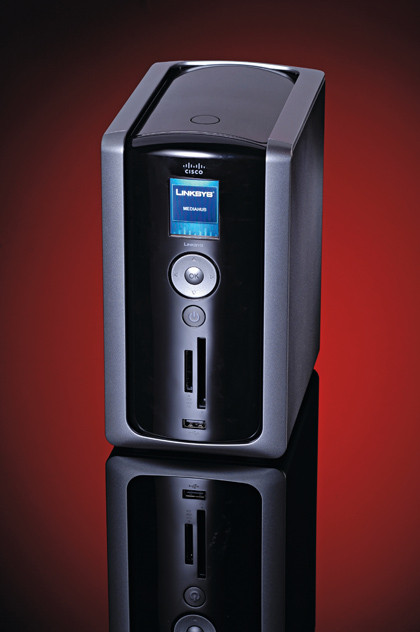Why go as far as a dedicated NAS device? There's a range of USB-to-Ethernet hubs now available that allow you to connect external hard drives to your network. Dedicated, multiport devices such as the Belkin Home Base may be a bit pricey, but more and more routers – such as Netgear's RangeMax WNDR3700 – are turning up with a single USB port that does the same thing, built-in alongside the Ethernet connections.

One of the advantages of a USB bridge is that it can also hook up printers and scanners so they can be accessed from anywhere. If you want to use one for hard drives, make sure they have a NAS mode, otherwise only one machine will be able to access the drive at a time.
There are two reasons you might want to go for a 'proper' NAS device. The first is that they offer an extra layer of security through RAID mirroring, so you'll have a secondary backup of all your music, video and photo files should disaster strike. The second is that they tend to be a lot faster than networked USB hubs.
Neither will come close to filling a gigabit router's bandwidth, but read and write speeds are often five or six times quicker for NAS units. It's the difference between jitter-free HD video playback and taking all night just to back up a single film.
When it comes to bonus features, the Home Base isn't far behind, competing with high-end NAS devices through its ability to automatically sync photo folders with Flickr or Picasa.
For all the methods of moving your media around a home LAN, the most important factor to consider is the quality of the network itself. As a rule, streaming music from one PC to another is straightforward on any reasonable connection, from older 802.11g wireless kit upwards. Even lossless audio barely takes up a fraction of the available bandwidth of Wireless N, Ethernet or powerline adaptors.
Video, on the other hand, is going to need something faster and more reliable, especially if you plan to watch a lot of HD content remotely. If you don't mind getting out the drill, cabling the house for hard-wired Ethernet is still the most reliable way of shifting content around.
Sign up for breaking news, reviews, opinion, top tech deals, and more.
Both 802.11n and Ethernet-over-powerline adaptors designed to the HomePlug AV standard are also capable of handling HD video. Indeed, if you make sure that Quality of Service settings – which prioritise time-sensitive information such as video and voice – are enabled, they might even be better in some cases.
In ideal conditions, the former can provide 300Mbps, while the latter works at 200Mbps, but which one is suitable for you will depend on the construction of your home. In a typical house, you can expect around 140Mbps from both, more than enough for the 20Mbps normally required by HD video.

HomePlug AV turns your mains ring into a giant Ethernet cable, with adaptors that plug into regular power sockets, so it isn't subject to the same dead areas as Wireless-N when it comes to thick walls. If your electrics aren't up to scratch, though, the signal soon degrades as the wiring gets older.
In the cloud
You might want to bypass the home network altogether and leap straight into the cloud by uploading all your media files and taking it from there. Indeed, commercial streaming services including Spotify and Hulu are turning into viable alternatives to owning files, especially if you live in the US, where video-on-demand is well established.
However, what if you want an online repository for files you've already paid for, or can't bear losing the joy of ownership? Well, Logitech's Squeezebox players can connect to a personal MP3 tunes locker into which you upload your tunes.
It's not a terrible idea, but uploading all your MP3s could take a while and only certain bitrates are supported. The same issue affects NAS devices or server software that allows you to stream songs from a home machine to any IP address (see the Linksys Media Hub review).

As far as video goes, you could try setting up a UPnP server on an Amazon cloud server, but we wouldn't recommend it. Of all these different ways to get media off one device and onto another, then, which would we recommend?
The answer: all of them. Rather than looking for a silver bullet to solve all your streaming issues, it's going to be far easier to use a mix of approaches depending on what hardware you already have.
The key thing is to avoid is unnecessary duplication, and planning around your existing network is the most stress-free way of approaching it. And if it turns out that after 15 years the best way of getting an MP3 file from one PC to another is to keep it stored on a USB key, well, that's not so bad, is it?